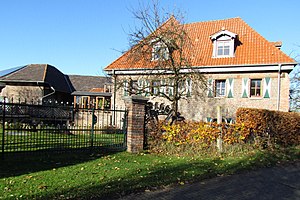Zweibrügger mill
| Zweibrügger mill
|
||
|---|---|---|
|
Zweibrügger Mühle in the Zweibrüggen district |
||
| Location and history | ||
|
|
||
| Coordinates | 50 ° 56 '10 " N , 6 ° 5' 56" E | |
| Location | Germany | |
| Waters | worm | |
| Built | 1450 mentioned in a document | |
| Shut down | 1974 | |
| technology | ||
| use | Grain and Oil Mill | |
| Grinder | 2 grinding courses 1 oil press | |
| drive | 3 water wheels | |
| water wheel | undershot | |
The Zweibrügger Mühle was a water mill with three undershot water wheels on the Wurm in the city of Übach-Palenberg in the North Rhine-Westphalian district of Heinsberg in the administrative district of Cologne .
geography
The two Brügger mill has its location on the left side of the worm Zweibrüggen no. 85, in the district of Zweibrüggen in the city Übach-Palenberg. The height at which the building stands today is around 80 m above sea level . The Marienthaler Mühle was located above ; the Frelenberger Mühle once worked below .
Waters
The worm supplied numerous mills with water over a river length of 53 km. The source of the worm is located south of Aachen at 265 m above sea level, the confluence with the Rur is in the town of Kempen in the city of Heinsberg at 32 m above sea level. In the late 1960s and early 1970s, worm straightening was carried out. The curving, now and then meandering course of the river disappeared in favor of a simple route . The river length shortened and the flow speed increased. For many people the flood protection improved , for the mills it was the end. The water association Eifel-Rur (WVER) is responsible for the care and maintenance of the water body with a catchment area of 355.518 km 2 .
history
The Zweibrügger mill was first mentioned in a document from 1450. The Heinsberg rulers left the mill to the Machartz clan for life. In return, the latter then waives a claim against the sovereign. The mill was equipped with a ban area that extended to six surrounding villages . Including Scherpenseel in the west, and the 5 km away Beggendorf in the east. Übach belonged to the Limburg Abbey of Thorn and was exempt from the mill obligation. In the 19th century the mill had three water wheels , two grinding stages and an oil press . The last watermill operated in the Heinsberg district, worked as a grinding mill until the worm was straightened and was shut down in 1974. After a building renovation , the water wheel was put back in place.
Monument entry
Zweibrügger Mühle : Two-story brick mill building , e.g. Partly in half-timbered now in brick, the mill wheel is still there on the outside, the building itself with a hipped roof . Date: 18th, 19th century. Registration as a memorial on August 17, 1992.
Monument List Übach-Palenberg No. 21
gallery
Zweibrügger Mühle on the tranchot card 1805/1807
Worm renaturation
The worm is allowed to squirm again. Such a press release from February 25, 2013 in the Aachener Zeitung about the renaturation of a 400 m long stretch of the Wurm in the area of the Zweibrügger mill.
literature
- Hans Vogt: Lower Rhine water mill guide 2nd edition. Verein Niederrhein, Krefeld 1998, ISBN 3-00-002906-0 , pages 284–285.
→ See also the list of mills on the Wurm
Web links
Individual evidence
- ^ German basic map 1: 5000
- ↑ Topographical Information Management, Cologne District Government, Department GEObasis NRW ( Notes )
- ↑ Archive link ( Memento of the original from October 17, 2013 in the Internet Archive ) Info: The archive link was inserted automatically and has not yet been checked. Please check the original and archive link according to the instructions and then remove this notice.
- ↑ http://www.wver.de/
- ↑ http://www.aachener-zeitung.de/lokales/heinsberg/die-wurm-darf-sich-wieder-mehr-iegen-1.526169








